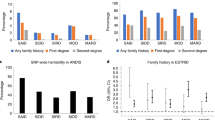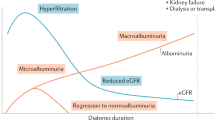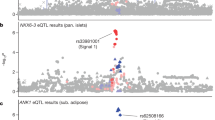Abstract
Non–insulin–dependent (type 2) diabetes mellitus (NIDDM) is a common disorder of middle–aged individuals characterized by high blood glucose levels which, if untreated, can cause serious medical complications and lead to early death. Genetic factors play an important role in determining susceptibility to this disorder. However, the number of genes involved, their chromosomal location and the magnitude of their effect on NIDDM susceptibility are unknown. We have screened the human genome for susceptibility genes for NIDDM using non– and quasi-parametric linkage analysis methods in a group of Mexican American affected sib pairs. One marker, D2S725, showed significant evidence of linkage to NIDDM and appears to be a major factor affecting the development of diabetes mellitus in Mexican Americans. We propose that this locus be designated NIDDM1.
This is a preview of subscription content, access via your institution
Access options
Subscribe to this journal
Receive 12 print issues and online access
$209.00 per year
only $17.42 per issue
Buy this article
- Purchase on Springer Link
- Instant access to full article PDF
Prices may be subject to local taxes which are calculated during checkout
Similar content being viewed by others
References
DeFronzo, R.A., Bonadonna, R.C. & Ferrannini, E. Pathogenesis of NIDDM: a balanced overview. Diabetes Care 15, 318–368 (1992).
King, H. & Rewers, M. Global estimates for prevalence of diabetes mellitus and impaired glucose tolerance in adults. Diabetes Care 16, 157–177 (1993).
Harris, M.I., Diabetes in America, 2nd edn. 1–13 (NIH Publication No. 95–1468,1995).
Rotter, J.I., Vadheim, C.M. & Rimoin, D.L. Diabetes mellitus. in The Genetic Basis of Common Diseases (eds King, R.A., Rotter, J.I. & Motulsky, A.G.) 413–481 (Oxford University Press, New York, 1992).
Turner, R.C., Hattersy, AT., Shaw, J.T.E & Levy, J.C. Type II diabetes: clinical aspects of molecular biological studies. Diabetes 44, 1–10 (1995).
Fajans, S.S. Maturity-onset diabetes of the young. Diabetes/Metab. Rev. 5, 579–606 (1989).
Vaxillaire, M. et al. A gene for maturity onset diabetes of the young (MODY) maps to chromosome 12q. Nature Genet. 9, 418–423 (1995).
Byrne, M.M. et al. Altered insulin secretory responses to glucose in subjects with a mutation in the MODY1 gene on chromosome 20. Diabetes 44, 699–704(1995).
Froguel, P. et al. Familial hyperglycemia due to mutations in glucokinase. Definition of a subtype of diabetes mellitus. N. Engl. J. Med. 328, 697–702 (1993).
Grupe, A. et al. Transgenic knockouts reveal a critical requirement for pancreatic β cell glucokinase in maintaining glucose homeostasis. Cell 83, 69–78 (1995).
Ballinger, S.W. et al. Maternally transmitted diabetes and deafness associated with a 10.4 kb mitochondria! DNA deletion. Nature Genet. 1, 11–15 (1992).
van den Ouweland, J.M.V. et al. gene in a large pedigree with maternally transmitted type II diabetes mellitus and deafness. Nature Genet. 1, 368–371 (1992).
Steiner, D.F., Tager, H.S., Nanjo, K., Chan, S.J. & Rubenstein, A.H. Familial syndromes of hyperproinsulinemia and hyperinsulinemia with mild diabetes In The Metabolic and Molecular Bases of Inherited Disease, (eds Scriver, C.R., Beaudet, A.L., Sly, W.S. & Valle, D.) 897–904 (McGraw-Hill, Inc., New York, 1995).
Taylor, S.I. Diabetes mellitus. in The Metabolic and Molecular Bases of Inherited Disease, (eds Scriver, C.R., Beaudet, A.L., Sly, W.S. & Valle, D.)843–896 (McGraw-Hill, Inc., New York, 1995).
Hamman, R.F. Genetic and environmental determinants of non-insulin-dependent diabetes mellitus (NIDDM). Diabetes Metab. Rev. 8, 287–338 (1992).
Lander, E. L Genetic dissection of complex traits: guidelines for interpreting and reporting linkage results. Nature Genet. 11, 241–247 (1995).
Hanis, C.L. et al. Mortality of Mexican Americans with NIDDM: retinopathy and other predictors in Starr County, Texas. Diabetes Care 16, 82–89 (1993).
Hanis, C.L., Hewett-Emmett, D., Bertin, T.K. & Schull, W.J. Origins of U.S.Hispanics: implications for diabetes. Diabetes Care 14, 618–627 (1991).
Holmans, P. Asymptotic properties of affected-sib-pair linkage analysis. Am. J. Hum. Genet. 52, 362–374 (1993).
Holmans, P. & Clayton, D. Efficiency of typing unaffected relatives in an affected-sib-pair linkage study with single-locus and multiple tightly linked markers. Am. J. Hum. Genet. 57, 1221–1232 (1995).
Bishop, D.T. & Williamson, J.A. The power of identity-by-state methods for linkage analysis. Am. J. Hum. Genet. 46, 254–265 (1990).
Risch, N. Exclusion mapping for complex diseases. Am. J. Hum. Genet. 53, A185 (1993).
Suarez, B.K. & Hodge, S.E. A simple method to detect linkage for rare recessive diseases: an application to juvenile diabetes. Clin. Genet. 15, 126–136 (1979).
Hodge, S.E. & Elston, R.C., Lods, wrods, and mods: the interpretation of lod scores calculated under different models. Genet. Epidemiol. 11, 329–342 (1994).
Curtis, D. & Sham, P.C. Model-free linkage analysis using likelihoods. Am. J. Hum. Genet. 57, 703–716 (1995).
Risch, N. Linkage strategies for genetically complex traits. II. the power of affected relative pairs. Am. J. Hum. Genet. 46, 229–241 (1990).
Gyapay, G. et al.The 1993–94 Généthon human genetic linkage map. Nature Genet. 7, 246–339 (1994).
Dib, C. et al. A comprehensive genetic map of the human genome based on 5,264 microsatellites. Nature 380, 152–154 (1996).
Norman, R.A., Bogardus, C. & Ravussin, E. Linkage between obesity and a marker near the tumor necrosis factor-α locus in Pima Indians. J. Clin. Invest. 96, 158–162 (1995).
Walston, J. et al. Time of onset of non-insulin-dependent diabetes mellitus and genetic variation in the β3-adrenergic-receptor gene. N. Engl. J. Med. 333, 342–347 (1995).
Widen, E. et al. Association of polymorphism in the β3-adrenergic-receptor gene with features of the insulin resistance syndrome in Finns. N. Engl. J. Med. 333, 348–351 (1995).
Clement, K. et al. Genetic variation in the β3-adrenergic receptor and an increased capacity to gain weight in patients with morbid obesity. N. Engl. J. Med. 333, 352–354 (1995).
Davies, J.L. 1 diabetes susceptibility genes. Nature 371, 130–136 (1994).
Hashimoto, L. et al. Genetic mapping of a susceptibility locus for insulin-dependent diabetes mellitus on chromosome 11q. Nature 371, 161–164 (1994).
Todd, J.A. Genetic analysis of type 1 diabetes using whole genome approaches. Proc. Natl. Acad. Sci. USA 92, 8560–8565 (1995).
Hager, J. et al. A missense mutation in the glucagon receptor gene is associated with non- insulin dependent diabetes mellitus. Nature Genet. 9, 299–304 (1995).
Thompson, D.B. et al. Evidence for linkage between a region on chromosome 1 p and the acute insulin response in Pima Indians. Diabetes 44, 478–481 (1995).
Prochazka, M. et al. Linkage of chromosomal markers on 4q with a putative gene determining maximal insulin action in Pima Indians. Diabetes 42, 514–619 (1993).
Iwasaki, N. Identification of microsatellite markers near the human genes encoding the β- cell ATP-sensitive K+ channel and linkage studies with NIDDM in Japanese. Diabetes 45, 267–269 (1996).
Hudson, T.J. et al.An STS-based map of the human genome. Science 270, 1945–1954 (1995).
Harris, M.I., classification, diagnositic criteria, and screening for diabetes, in Diabetes in America, 2nd edn. 15–36 (NIH Publication No. 95-1468,1995).
Fasman, K.H., Cuticchia, A.J. & Kingsbury, D.T. The GDB human genome data base anno 1994. Nucl. Adds Res. 22, 3462–3469 (1994).
Lathrop, G.M., Lalouel, J.M., Julier, C. & Ott, J. Multilocus linkage analysis in humans: detection of linkage and estimation of recombination. Am. J. Hum. Genet. 37 482–498 (1985).
Yamagata, K. et al.Searching for NIDDM susceptibility genes: studies of genes with triplet repeats expressed in skeletal muscle. Diabetologia(in the press).
Author information
Authors and Affiliations
Rights and permissions
About this article
Cite this article
Hanis, C., Boerwinkle, E., Chakraborty, R. et al. A genome–wide search for human non–insulin–dependent (type 2) diabetes genes reveals a major susceptibility locus on chromosome 2. Nat Genet 13, 161–166 (1996). https://doi.org/10.1038/ng0696-161
Received:
Accepted:
Issue Date:
DOI: https://doi.org/10.1038/ng0696-161



